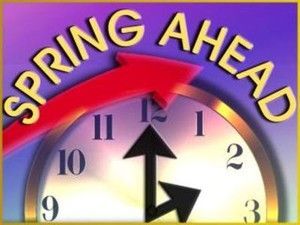THINGS YOU DIDN’T KNOW ABOUT TIME
Daylight Saving Time begins this Sunday
![]() The average U.S. city commuter loses 38 hours a year to traffic delays.
The average U.S. city commuter loses 38 hours a year to traffic delays.
![]() Wonder why you have to set your clock ahead in March? Daylight Saving Time began as a joke by Benjamin Franklin, who proposed waking people earlier on bright summer mornings so they might work more during the day and thus save candles. It was introduced in the U.K. in 1917 and then spread around the world.
Wonder why you have to set your clock ahead in March? Daylight Saving Time began as a joke by Benjamin Franklin, who proposed waking people earlier on bright summer mornings so they might work more during the day and thus save candles. It was introduced in the U.K. in 1917 and then spread around the world.
![]() The Department of Energy estimates that electricity demand drops by 0.5 percent during Daylight Saving Time, saving the equivalent of nearly 3 million barrels of oil.
The Department of Energy estimates that electricity demand drops by 0.5 percent during Daylight Saving Time, saving the equivalent of nearly 3 million barrels of oil.
![]() By observing how quickly bank tellers made change, pedestrians walked, and postal clerks spoke, psychologists determined that the three fastest-paced U.S. cities are Boston, Buffalo, and New York. The three slowest? Shreveport, Sacramento, and L.A.
By observing how quickly bank tellers made change, pedestrians walked, and postal clerks spoke, psychologists determined that the three fastest-paced U.S. cities are Boston, Buffalo, and New York. The three slowest? Shreveport, Sacramento, and L.A.
![]() One second used to be defined as one-86-thousand-four-hundreth the length of a day. However, Earth’s rotation isn’t perfectly reliable. Tidal friction from the sun and moon slows our planet and increases the length of a day by 3 milliseconds per century.
One second used to be defined as one-86-thousand-four-hundreth the length of a day. However, Earth’s rotation isn’t perfectly reliable. Tidal friction from the sun and moon slows our planet and increases the length of a day by 3 milliseconds per century.
![]() Weather also changes the day. During El Niño events, strong winds can slow Earth’s rotation by a fraction of a millisecond every 24 hours.
Weather also changes the day. During El Niño events, strong winds can slow Earth’s rotation by a fraction of a millisecond every 24 hours.
![]() In 1972 a network of atomic clocks in more than 50 countries was made the final authority on time, so accurate that it takes 31.7 million years to lose about one second. To keep this time in sync with Earth’s slowing rotation, a “leap second” must be added every few years, most recently this past New Year’s Eve.
In 1972 a network of atomic clocks in more than 50 countries was made the final authority on time, so accurate that it takes 31.7 million years to lose about one second. To keep this time in sync with Earth’s slowing rotation, a “leap second” must be added every few years, most recently this past New Year’s Eve.
![]() The world’s most accurate clock, at the National Institute of Standards and Technology in Colorado, measures vibrations of a single atom of mercury. In a billion years it will not lose one second.
The world’s most accurate clock, at the National Institute of Standards and Technology in Colorado, measures vibrations of a single atom of mercury. In a billion years it will not lose one second.
![]() Until the 1800s, every village lived in its own little time zone, with clocks synchronized to the local solar noon. This caused havoc with the advent of trains and timetables. For a while watches were made that could tell both local time and “railway time.” On November 18, 1883, American railway companies forced the national adoption of standardized time zones.
Until the 1800s, every village lived in its own little time zone, with clocks synchronized to the local solar noon. This caused havoc with the advent of trains and timetables. For a while watches were made that could tell both local time and “railway time.” On November 18, 1883, American railway companies forced the national adoption of standardized time zones.
![]() Einstein showed that gravity makes time run more slowly. Thus airplane passengers, flying where Earth’s pull is weaker, age a few extra nanoseconds each flight.
Einstein showed that gravity makes time run more slowly. Thus airplane passengers, flying where Earth’s pull is weaker, age a few extra nanoseconds each flight.
![]() There may be an end of time. Three Spanish scientists posit that the observed acceleration of the expanding cosmos is an illusion caused by the slowing of time. According to their math, time may eventually stop, at which point everything will come to a standstill.
There may be an end of time. Three Spanish scientists posit that the observed acceleration of the expanding cosmos is an illusion caused by the slowing of time. According to their math, time may eventually stop, at which point everything will come to a standstill.

